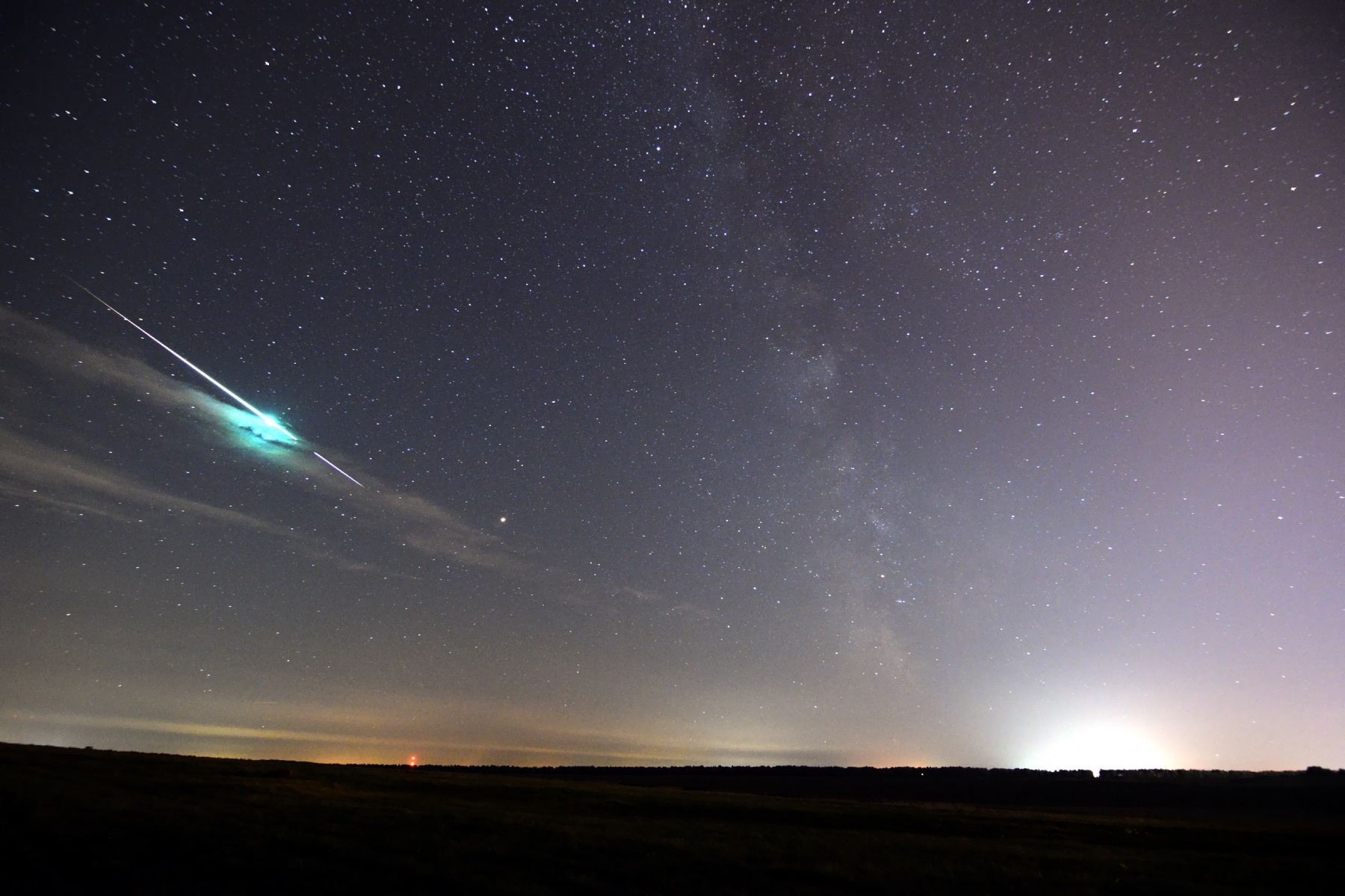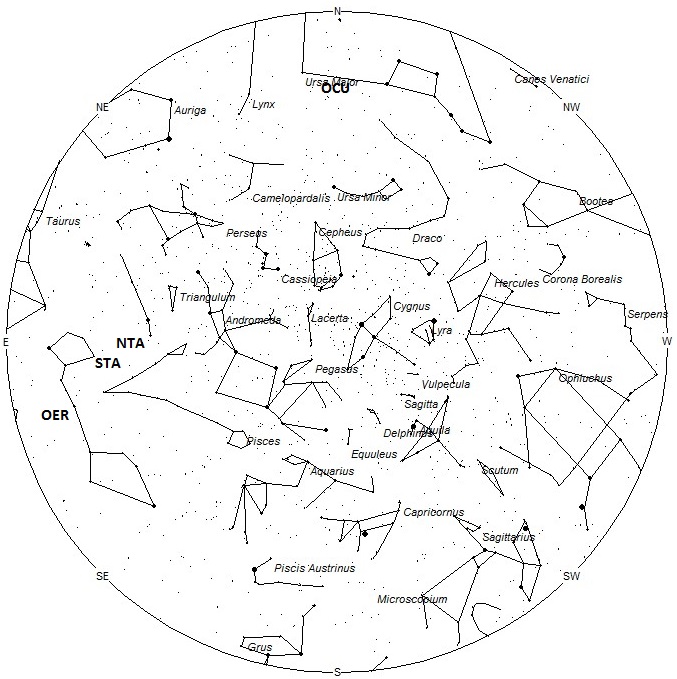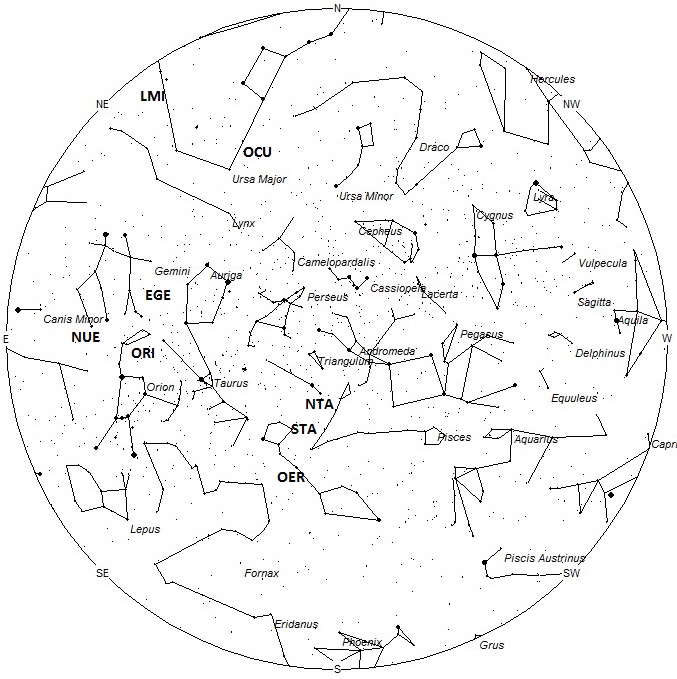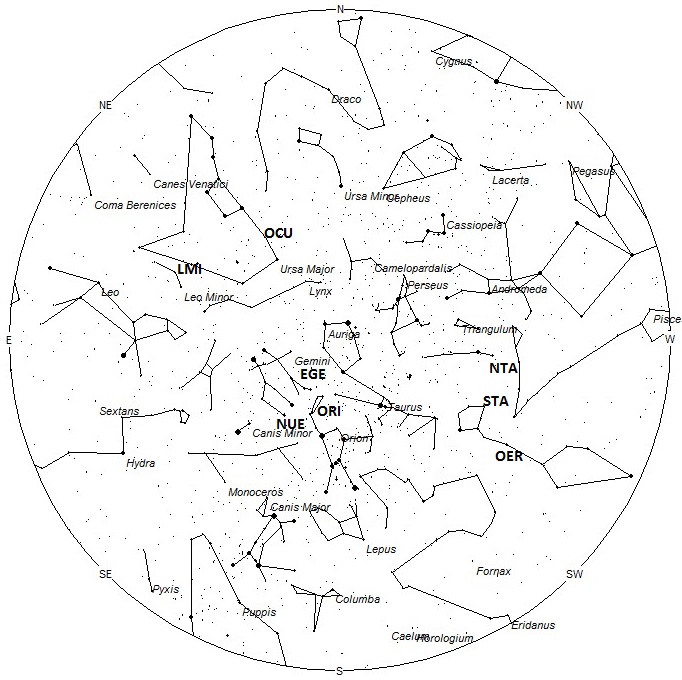 This fantastic fireball/cloud photograph was captured by Monika L. from near Veszprém, Hungary. It was captured on September 28, 2018 at 18:28 Universal Time. She commented that it was slow and may have produced sounds.
This fantastic fireball/cloud photograph was captured by Monika L. from near Veszprém, Hungary. It was captured on September 28, 2018 at 18:28 Universal Time. She commented that it was slow and may have produced sounds.During this period the moon will reach its full phase on Wednesday October 24h. At this time the moon will be located opposite the sun and will lie above the horizon all night long. This weekend the waxing gibbous moon will set during the early morning hours leaving a small window of opportunity to view under dark skies between moonset and the start of morning twilight. The estimated total hourly meteor rates for evening observers this week is near 3 for those viewing from the northern hemisphere and 2 for those located south of the equator. For morning observers the estimated total hourly rates should be near 18 as seen from mid-northern latitudes and 13 from the southern tropics. Rates are reduced during this period due to moonlight. The actual rates will also depend on factors such as personal light and motion perception, local weather conditions, alertness and experience in watching meteor activity. Note that the hourly rates listed below are estimates as viewed from dark sky sites away from urban light sources. Observers viewing from urban areas will see less activity as only the brighter meteors will be visible from such locations.
The radiant (the area of the sky where meteors appear to shoot from) positions and rates listed below are exact for Saturday night/Sunday morning October 20/21. These positions do not change greatly day to day so the listed coordinates may be used during this entire period. Most star atlases (available at science stores and planetariums) will provide maps with grid lines of the celestial coordinates so that you may find out exactly where these positions are located in the sky. A planisphere or computer planetarium program is also useful in showing the sky at any time of night on any date of the year. Activity from each radiant is best seen when it is positioned highest in the sky, either due north or south along the meridian, depending on your latitude. It must be remembered that meteor activity is rarely seen at the radiant position. Rather they shoot outwards from the radiant so it is best to center your field of view so that the radiant lies at the edge and not the center. Viewing there will allow you to easily trace the path of each meteor back to the radiant (if it is a shower member) or in another direction if it is a sporadic. Meteor activity is not seen from radiants that are located far below the horizon. The positions below are listed in a west to east manner in order of right ascension (celestial longitude). The positions listed first are located further west therefore are accessible earlier in the night while those listed further down the list rise later in the night.
These sources of meteoric activity are expected to be active this week..
The Northern Taurids (NTA) are active from a large radiant located at 02:26 (037) +18. This area of the sky is located in central Aries, 5 degrees southeast of the 2nd magnitude star known as Hamal (alpha Arietis). This position is close to the Southern Taurids so care must be taken in separating these meteors. You should have the two radiants near the center of your field of view to properly differentiate these sources. The maximum is not expected until early November so current rates would be 1 per hour or less. These meteors may be seen all night long but the radiant is best placed near 0200 LST when it lies on the meridian and is located highest in the sky. With an entry velocity of 28 km/sec., the average Northern Taurid meteor would be of slow velocity.
The Southern Taurids (STA) are active from a large radiant centered near 02:40 (040) +11. This position lies in southern Aries, 2 degrees northwest of the 4th magnitude star known as mu Ceti. These meteors may be seen all night long but the radiant is best placed near 0200 LST when it lies on the meridian and is located highest in the sky. Rates at this time should be near 2 per hour regardless of your location. With an entry velocity of 27 km/sec., the average Southern Taurid meteor would be of slow velocity.
The omicron Eridanids (OER) were discovered by Japanese observers using video data from SonotoCo in 2007-2008. The activity period ranges from October 16 – November 24 with maximum activity occurring on November 4th. This is a weak shower that usually produces rates less than 1 per hour, even at maximum activity. The radiant is currently located at 02:44 (041) -03, which places it on the Cetus/Eridanus border, 5 degrees south of the 3rd magnitude star known as Menkar (alpha Ceti). This location is close to the source of the Southern Taurids so care must be taken to separate these meteors. Like the STA’s these meteors may be seen all night long but the radiant is best placed near 0200 LST when it lies on the meridian and is located highest in the sky. With an entry velocity of 29 km/sec., the average omicron Eridanid meteor would be of slow velocity.
The chi Taurids (CTA) were discovered by Dr. Peter Brown during his 7 year survey using the Canadian Meteor Orbit Radar (CMOR). This source is active from October 20 through November 17 with a maximum occurring near November 3rd. Current rates would be less than 1 per hour no matter your location. The radiant is currently located at 03:15 (049) +24, which places it in eastern Aries , 6 degrees west of the famous naked eye open cluster known as the Pleiades. This location is close to the source of the Northern Taurids so care must be taken to separate these meteors. These meteors may be seen all night long but the radiant is best placed near 0300 LST when it lies on the meridian and is located highest in the sky. With an entry velocity of 41 km/sec., the average chi Taurid meteor would be of medium velocity.
The Orionids (ORI) reach maximum activity on the morning of October 22nd. Unfortunately the full moon will obscure all but the brighter meteors, severely reducing the number of meteors seen. The is radiant located at 06:20 (095) +16, which places it in northeastern Orion, 3 degrees west of the 2nd magnitude star known as Alhena (gamma Geminorum). This area of the sky rise between 2200 and 2300 and is best placed near 05:00 LST, when it lies highest above the horizon. Rates with moonlight, with the radiant high in the sky, should be near 5 per hour no matter your location. With an entry velocity of 67 km/sec., most activity from this radiant would be of swift speed.
The nu Eridanids (NUE) were co-discovered by Japanese observers using SonotoCo and Juergen Rendtel and Sirko Molau of the IMO. Activity from this long-period stream stretches from August 23 all the way to November 16. A very shallow maximum occurred near September 24. The radiant currently lies at 06:24 (103) +12, which places it in northeastern Monoceros, 2 degrees southeast of the 3rd magnitude star known as Alzirr (xi Geminorum). This area of the sky is best seen during the last dark hour before dawn when the radiant lies highest in a dark sky. Current rates are expected to be less than 1 per hour during this period no matter your location. With an entry velocity of 67 km/sec., the average meteor from this source would be of swift velocity. Some experts feel that these meteors are early members of the Orionid shower, which peaks on October 22.
The epsilon Geminids (EGE) are active from September 30 through October 25 with maximum activity occurring on October 11. The radiant is currently located at 06:29 (105) +28, which places it in north-central Gemini, 4 degrees northeast of the 3rd magnitude star known as Mebsuta (epsilon Geminorum). This area of the sky is best placed in the sky during the last hour before dawn, when it lies highest above the horizon in a dark sky. Current rates should be less than 1 no matter your location. With an entry velocity of 70 km/sec., most activity from this radiant would be of swift speed.
The lambda Ursae Majorids (LUM) are a recent discovery by Željko Andreić and the Croatian Meteor Network team based on studying SonotaCo and CMN observations (SonotaCo 2007-2011, CMN 2007-2010). This weak shower is active from October 27-29 maximum activity occurring on the 28th. At maximum the radiant is located at 10:24 (156) +49. This position lies in a sparse area of central Ursa Major, between the 2nd magnitude star Merak (Beta Ursae Majoris) and 3rd magnitude Tania Borealis (Lambda Ursa Majoris). This area of the sky is best placed in the sky during the last hour before dawn, when it lies highest above the horizon in a dark sky. Rates at maximum would be less than 1 no matter your location. With an entry velocity of 61 km/sec., most activity from this radiant would be of swift speed.
The Leonis Minorids (LMI) are active from October 12-Nov 5 with maximum activity occurring on October 22nd. This radiant is currently located at 10:36 (159) +37, which places it in northeastern Leo Minor, 2 degrees northeast of the 4th magnitude star known as beta Leonis Minoris. The radiant is best placed just before dawn when it lies highest in a dark sky. This shower is better situated for observers situated in the northern hemisphere where the radiant rises far higher into the sky before the start of morning twilight. Current rates would be less than 1 no matter your location. At 62km/sec., the average Leonis Minorid is swift. From my personal experience this minor shower produces a high proportion of bright meteors.
As seen from the mid-northern hemisphere (45N) one would expect to see approximately 8 sporadic meteors per hour during the last hour before dawn as seen from rural observing sites. Evening rates would be near 2 per hour. As seen from the tropical southern latitudes (25S), morning rates would be near 6 per hour as seen from rural observing sites and 1 per hour during the evening hours. Locations between these two extremes would see activity between the listed figures. Rates are reduced during this period due to moonlight.
The list below offers the information from above in tabular form. Rates and positions are exact for Saturday night/Sunday morning except where noted in the shower descriptions.
| SHOWER | DATE OF MAXIMUM ACTIVITY | CELESTIAL POSITION | ENTRY VELOCITY | CULMINATION | HOURLY RATE | CLASS |
| RA (RA in Deg.) DEC | Km/Sec | Local Summer Time | North-South | |||
| Northern Taurids (NTA) | Nov 02 | 02:26 (037) +18 | 28 | 02:00 | 1 – <1 | II |
| Southern Taurids (STA) | Oct 29 | 02:40 (040) +11 | 27 | 02:00 | 2 – 2 | II |
| omicron Eridanids (OER) | Nov 04 | 02:44 (041) -03 | 29 | 02:00 | <1 – <1 | IV |
| chi Taurids (CTA) | Nov 03 | 03:15 (049) +24 | 41 | 03:00 | <1 – <1 | IV |
| Orionids (ORI) | Oct 22 | 05:51 (088) +16 | 67 | 05:00 | 5 – 4 | I |
| nu Eridanids (NUE) | Sep 24 | 06:24 (096) +10 | 67 | 06:00 | 1 -1 | IV |
| epsilon Geminids (EGE) | Oct 11 | 06:29 (105) +28 | 70 | 06:00 | <1 – <1 | II |
| lambda Ursae Majorids (LUM) | Oct 28 | 10:24 (156) +49 | 62 | 10:00 | <1 – <1 | IV |
| Leonis Minorids (LMI) | Oct 22 | 10:36 (159) +37 | 62 | 10:00 | 1 – <1 | IV |







 You saw something bright and fast? Like a huge shooting star? Report it: it may be a fireball.
You saw something bright and fast? Like a huge shooting star? Report it: it may be a fireball.  You counted meteors last night? Share your results with us!
You counted meteors last night? Share your results with us!  You took a photo of a meteor or fireball? You have a screenshot of your cam? Share it with us!
You took a photo of a meteor or fireball? You have a screenshot of your cam? Share it with us!  You caught a meteor or fireball on video? Share your video with us!
You caught a meteor or fireball on video? Share your video with us!